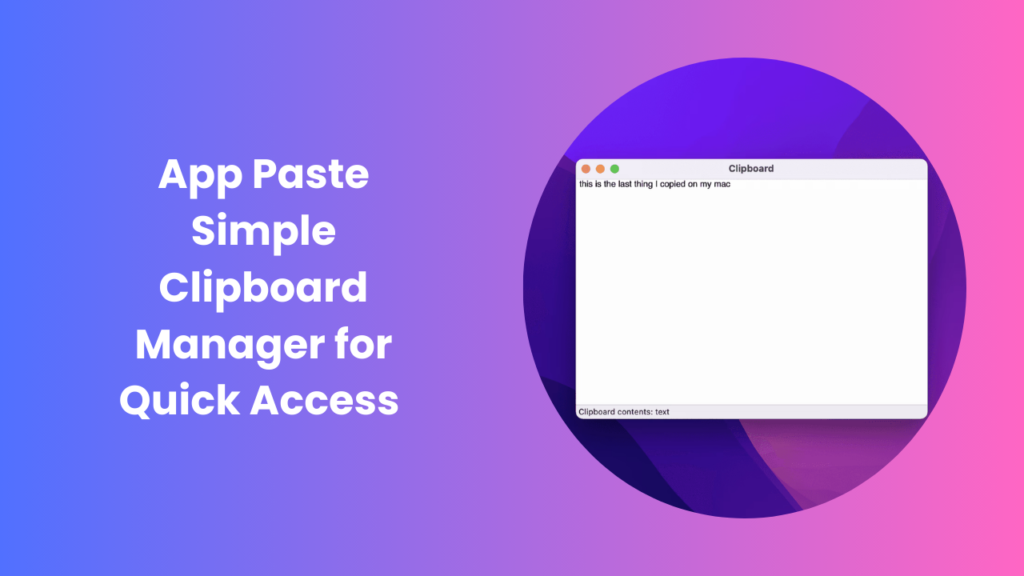In today’s fast-paced digital environment, efficiency is a top priority. People constantly switch between documents, emails, browsers, and applications, performing the same copy-and-paste action dozens of times each day. This simple task, although essential, often consumes more time than we realize. Having a reliable way to manage copied text, images, and files can make the difference between a smooth workflow and constant frustration. This is exactly where app paste becomes an indispensable solution. It transforms an ordinary clipboard into a powerful productivity tool, making it easier to organize, retrieve, and reuse content without interruption.
Why Clipboard Management Has Become Essential
For years, the built-in clipboard function was considered sufficient. It allowed one item to be copied and pasted at a time, and for casual use this seemed adequate. However, as digital work has grown more complex, so have the demands placed on simple tools. Modern professionals, students, and content creators often deal with multiple references, large projects, and constant multitasking. The limitation of having just one copied item available no longer fits the way people work today.
This is why dedicated clipboard managers have become so valuable. They extend the capabilities of the default system clipboard, storing multiple copied items in a history and giving users instant access whenever needed. Instead of searching through files again or retyping content, users can retrieve their saved data with just a few clicks.
Features That Define a Good Clipboard Manager
Clean and Accessible Interface
A good productivity tool should be easy to understand, even for new users. Advanced features mean little if the interface feels overwhelming. That’s why top clipboard managers focus on simplicity, offering clean layouts where copied items can be easily found, searched, and reused.
Extended History and Archive Options
Unlike the default clipboard, which discards old items as soon as something new is copied, a dedicated manager maintains a searchable history. This allows people to revisit previously copied material without having to repeat the process. It is especially useful for research, project planning, and creative work.
Cross-Platform Synchronization
One of the biggest advantages of modern clipboard apps is cross-device functionality. Imagine copying an important quote on a laptop and instantly accessing it on a phone while on the move. Synchronization makes this possible, creating a seamless transition between devices without losing data.
Security and Privacy Protection
Any tool that handles sensitive information must prioritize security. Clipboard managers now integrate encryption features, ensuring that confidential notes, passwords, or private data remain safe. For professionals handling sensitive projects, this provides reassurance that their data is not vulnerable.
How These Tools Enhance Productivity
Reducing Repetitive Effort
Copy-paste tasks are often repeated countless times in a day. Without a manager, users must go back and recopy items they accidentally lose. Having an archive eliminates this waste of time, allowing individuals to focus on actual work rather than routine tasks.
Organizing Information for Later Use
Clipboard managers do more than store data—they allow users to categorize information. Whether you are writing academic papers, preparing marketing campaigns, or coding software, keeping references sorted makes work more efficient. Organized access ensures that no important snippet is lost in the shuffle.
Smooth Integration into Workflows
These applications are designed to integrate seamlessly with browsers, email clients, design tools, and word processors. This makes it easy for users to access saved items no matter where they are working. Instead of disrupting the flow, the clipboard becomes a silent assistant.
App Paste and Its Role in Modern Workflows
Among the growing number of clipboard solutions, app paste has emerged as a standout choice for many professionals. Its intuitive design, unlimited storage history, and advanced synchronization features make it more than just a convenience. It becomes a cornerstone of digital productivity, helping individuals save time and energy while maintaining focus on important tasks. By reducing friction in everyday workflows, this tool empowers users to achieve more with less effort.
Comparing Traditional and Modern Clipboard Tools
The difference between a default clipboard and a dedicated manager is striking. Traditional systems are limited to one copied item, require constant repetition, and function only on a single device. Modern tools, on the other hand, provide unlimited history, quick search capabilities, and synchronization across platforms. This evolution reflects the shift in digital work itself—moving from simple, one-dimensional needs to complex, multitasking environments where efficiency is critical.
Who Benefits the Most from Clipboard Managers
Students and Academics
Research projects often involve gathering data from multiple sources. A clipboard manager saves every copied reference, note, or citation, eliminating the risk of losing track of valuable information. In addition, when students need to compile bibliographies or revisit earlier material, everything is readily available. This not only saves time but also helps in maintaining accuracy throughout their work.
Business Professionals
Emails, presentations, and documents often contain repeated content such as templates, signatures, or proposals. A manager allows professionals to retrieve and reuse these items instantly, cutting down repetitive typing. For executives and managers working with tight deadlines, this can make daily communication significantly more efficient.
Writers and Content Creators
Writers frequently need to switch between drafts, quotes, and references. Developers often handle code snippets across multiple projects. Having everything saved in one place means less frustration and greater accuracy. For creative professionals, inspiration often strikes unexpectedly, and having quick access to stored resources allows them to channel ideas more effectively.
Designers and Marketers
For designers, the ability to store images, layouts, and text snippets can greatly reduce the time spent on repetitive tasks. Marketers benefit by keeping campaign copy, hashtags, and brand guidelines stored for easy access, ensuring consistency across platforms.
Extended Use Cases and Real-Life Scenarios
Consider a university researcher working on a thesis. Instead of juggling multiple tabs and retyping data, the researcher uses a clipboard manager to collect articles, quotes, and references in one place. When it’s time to write, everything is neatly stored and easily retrievable.
Now imagine a project manager coordinating with a remote team. With constant communication through email, chat platforms, and project tools, they need to reuse key instructions and documents. Instead of rewriting or hunting for files, they pull the needed items directly from their clipboard history, maintaining clarity and saving time.
Even in creative industries, such as video editing or content production, having stored snippets of scripts, templates, or subtitles can prevent delays. These examples highlight how the simple act of managing a clipboard more effectively can transform workflows in different industries.
The Future of Clipboard Technology
The evolution of clipboard tools is far from over. Developers are experimenting with AI-powered categorization, predictive search, and intelligent suggestions. These enhancements could make the tools even more powerful, learning from user behavior to anticipate what information might be needed next. With advancements in cloud storage and AI, the clipboard of tomorrow could become an intelligent assistant, not just a storage tool.
Future updates may also focus on integration with virtual and augmented reality environments, where digital workspaces expand beyond screens. In such contexts, having an intelligent clipboard could become vital for navigating vast amounts of information in immersive ways. As the workplace shifts toward more flexible, digital-first environments, clipboard managers will continue to adapt and grow.
FAQs
What is a clipboard manager?
A clipboard manager is a software tool that expands the capabilities of the default system clipboard. Instead of storing only one copied item, it saves multiple items in a searchable history, making it easier to retrieve past content.
Is it safe to use a clipboard manager?
Yes, most reputable clipboard managers use encryption and privacy controls to ensure your data is secure. Sensitive information such as passwords or confidential notes can be stored safely if you choose a trusted application.
Can clipboard managers work on multiple devices?
Many modern clipboard tools offer synchronization features that allow users to access copied content across laptops, tablets, and smartphones. This is especially helpful for people who frequently switch between devices.
Do clipboard managers slow down a computer?
Well-designed applications operate in the background with minimal resource use. Instead of slowing down performance, they often speed up workflows by reducing repetitive actions.
Who should consider using one?
Anyone who frequently copies and pastes content can benefit. This includes students, professionals, developers, writers, designers, and marketers. Essentially, if your work involves repeated data entry, a clipboard manager will save time and effort.
Are clipboard managers difficult to learn?
Not at all. Most are designed with user-friendly interfaces that make navigation simple. Even beginners can get started quickly, while advanced users can explore customization and integration options for more complex workflows.
Conclusion
Efficiency in the digital world comes down to small improvements that make a big difference. By turning a basic clipboard into a full-featured productivity tool, modern managers give users control over how they store and retrieve information. For those seeking a seamless way to work smarter, app paste is the solution that combines accessibility, organization, and cross-platform support. It proves that even the simplest tasks can be transformed into opportunities for better performance. With the right tool, productivity is no longer about working harder, it’s about working smarter.





